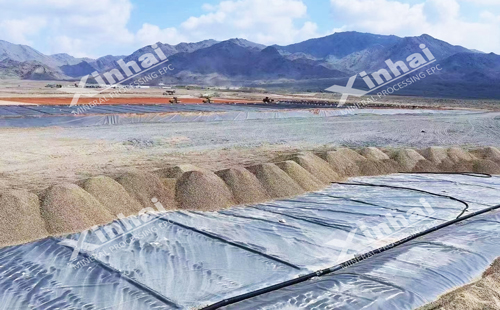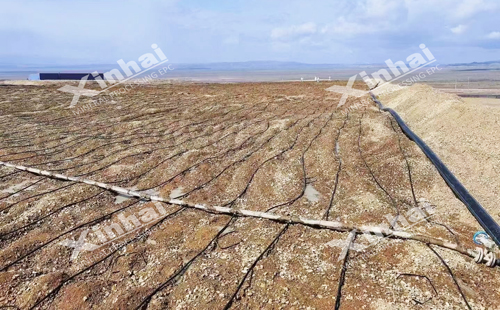
Heap leaching is a hydrometallurgy thing. You take a leach solution, usually with cyanide in it, and let it seep through a big pile of crushed ore. That dissolves the valuable metals. Then you collect the solution that has the metals in it – the pregnant solution – and process it to get the metals out.
Back in the 1960s, this technique came onto the scene. It was a great, cost - effective alternative to the old - fashioned milling methods. Over the years, we've gotten better at handling materials, designing the leach pads, and managing the reagents, which has made the whole process work a lot better.
There are lots of good reasons to go for heap leaching. First off, it doesn't cost as much to set up and run. It also uses less energy. And it can handle those low - grade ores that traditional methods might just ignore. Plus, if you manage it right, it doesn't mess up the environment too much.
Gold heap leaching is efficient for low grade gold ore. It makes up a big chunk of the world's gold production, especially in dry areas where saving water is a huge deal.

The best ores for heap leaching have certain features. They usually have a gold grade somewhere between 0.5 and 3.0 grams per ton. The minerals in the ore should be oxidized or weathered. They need to be pretty porous and have good permeability. And you don't want too much clay in there. Also, there shouldn't be any minerals that eat up the cyanide. The fine grains or trapped gold need to be pretreated.
Heap leaching is great for different kinds of gold deposits. Disseminated oxidized ores are a good fit. Also, sulfide ores where the gold isn't too tightly bound to the sulfide minerals can work. And it can handle placer and vein gold deposits with small gold particles.
You've got to do some tests in the lab and on a small pilot scale. Things like bottle roll and column leach tests are really important. They help you figure out what the ore is like and whether it'll leach well.
Crushing and Screening: You've got to crush the ore down to between 5 and 20 mm. That makes it easier for the solution to get through and exposes the gold particles.
Agglomeration: For the finer ores, you mix them with stuff like cement and cyanide solution to make them stick together. This improves the permeability and stops the solution from just flowing in channels.
Pretreatment: You should process gold which has clay or fine grains / trapped gold before leaching
Liner System: We use HDPE liners to stop the solution from leaking into the ground and protect the groundwater.
Solution Collection System: There are trenches and pipes to collect the pregnant solution so we can process it further.
Stormwater Management: The site is designed with drainage systems to deal with rain. We don't want the rain to dilute the leach solution.

Alright, let's talk about building the heap. There's a bunch of stuff you gotta remember. We stack the ore in layers, or “lifts” as we call it. Now, the height we stack it to?
On one hand, we need the heap to have good permeability. That way, the leaching solution can flow through the ore properly, doing its job of dissolving the gold. But on the other hand, we can't just stack it too high and hope for the best. The heap's gotta be stable, or else it'll just come crashing down, and that's a huge mess.
And then there's this whole deal about uniform permeability. You can't just throw the ore on there any which way. You have to stack it in a consistent manner. If you don't, it's like building a maze with some paths being super easy for the solution to follow. These are what we call preferential flow paths. When that happens, the solution won't spread evenly through the heap, and the gold won't get leached evenly either. It's just like water finding the easiest way through a cluttered room.
The leaching agent we use is an alkaline cyanide solution. First, we get it all ready, and then we spread it over the heap.
Now, pH control? 9 and 11. This specific pH range helps dissolve the gold as efficiently as possible. And it also saves us some cyanide, which is great because cyanide isn't exactly cheap or easy to handle.
As for getting the solution onto the heap, we've got options. Or we can use drip systems, which are more precise, like dropping water one by one. Either way, the goal is to make sure the solution spreads out evenly across the entire heap.
the leaching solution seeps through the gold ores. we will collect pregnant solution with dissolved gold at the bottom of heap leach
4Au+8NaCN+O₂+2H₂O→4Na[Au(CN)₂]+4NaOH
Some key factors affect how fast this reaction goes, the dissolution rate. Cyanide concentration is important. Adding more might speed it up, but there's a limit.
Oxygen's also crucial. Without enough, the reaction won't work well, just like a fire needs oxygen.
The pH matters, as we've said. And don't forget temperature. If it's too cold, the reaction slows down; if too hot, it can cause problems.
Gold and silver get adsorbed onto activated carbon through ion exchange. It's like a trading place where solution metals swap with carbon ions.
But several things can affect this. The solution flow rate matters. If it's too fast, the metals can't stick to the carbon. Metal concentration in the solution is important, too. And pH can change how metals interact with the carbon. Also, impurities in the solution can disrupt the whole process.
Getting metals off the loaded carbon is a job. We use methods like Zadra and pressure stripping. It's like removing something stuck.
After that, in electrowinning, we deposit the recovered metals onto cathodes. These cathodes store the metals safely for further processing.
The Merrill - Crowe process is simple. Add zinc powder to the pregnant solution, and gold and silver precipitate out.
But there are requirements. The solution must be clear. And we need to remove oxygen. Otherwise, zinc will react with other substances, wasting good zinc.

The Merrill - Crowe Process is a well - known way to get gold and silver from pregnant leach solutions, especially in high - grade heap leaching. Different from carbon adsorption methods that depend on gold's attraction to activated carbon, this one uses zinc powder to make precious metals come out of the solution directly.
Basically, the Merrill - Crowe Process has three main steps:
First is clarification. We filter the pregnant solution to get rid of any solids floating around. These solids could mess with the zinc precipitation.
Next is deaeration. We use a vacuum deaeration tower to take the oxygen out of the solution. it'll oxidize the zinc and make it less effective if there's oxygen.
Finally, we add zinc powder. When we put in finely divided zinc powder, a redox reaction happens. This makes gold and silver come out of the solution. After that, we filter, dry, and refine the precipitate.
This process is great when the gold concentration is high and we want to get as much gold as possible. It's also good for getting silver, and often works better than carbon - based methods for ores with a lot of silver.
Carbon adsorption (CIC or CIP) is more popular for low - to - medium - grade ores because it's simpler and cheaper. But the Merrill - Crowe Process is better for clean, clear solutions. It doesn't have problems with carbon getting dirty from organics or base metals, and can handle more solution in some cases.
New methods like selective silver precipitation using reagents such as sodium sulfide or thiosemicarbazide are emerging; they're not widely used yet but are helpful for ores with high silver - to - gold ratios or complex metals, and picking the best recovery method requires considering ore features, solution chemistry, and operation goals to maximize profits in heap leaching.
Lithium is a crucial element in electric vehicle batteries and energy storage systems. The demand for it has been soaring. Understanding how lithium is produced is really important these days. Let's take a look at the main methods and equipment used in lithium extraction and concentration, based on some leading mining technology sources.
It is vital for the stakeholders of the technology and energy sectors to understand how the hard rock lithium processing is conducted – from the first extraction of the mine to its final market form.
